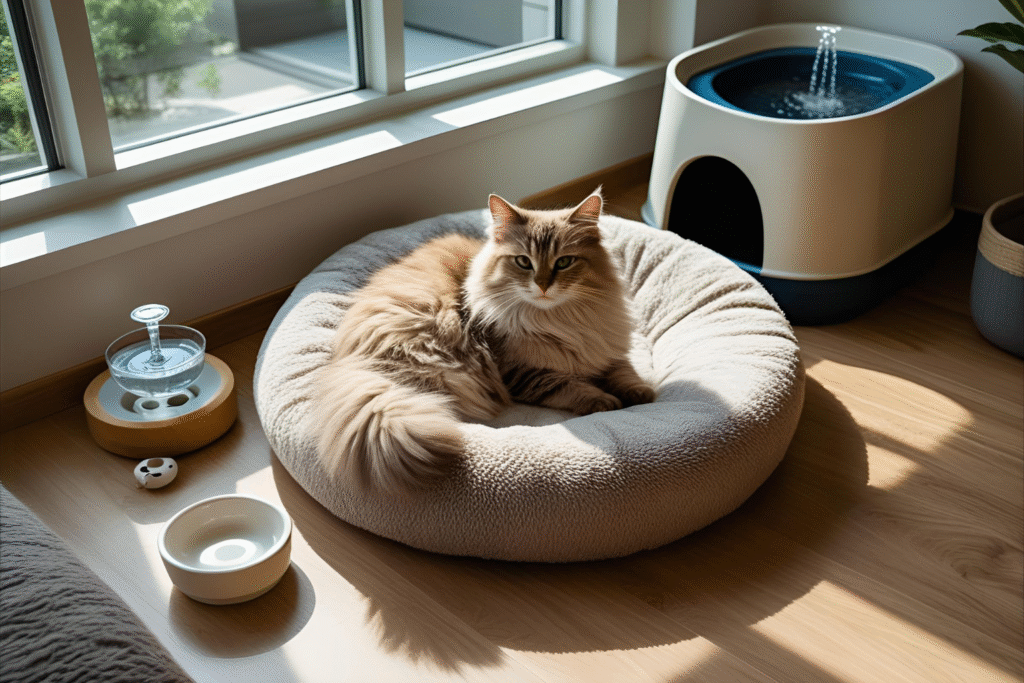
How to Set Up a Perfect Home for Your New Cat
How to Set Up a Perfect Home for Your New Cat: A Complete Guide for First-Time Cat Owners
Updated July 2025 • by Luna Hayes
🏡 Introduction: Bringing a New Cat Home
Adopting a cat is an exciting and rewarding experience, but preparing your home before their arrival is key to a smooth transition. Whether you’re bringing home a playful kitten or a calm senior cat, creating a welcoming, safe, and enriching environment helps your feline friend feel secure and loved.
✅ Step 1: Choose a Quiet & Safe Introduction Room
Cats are territorial and may feel overwhelmed in a new place. Pick a quiet, low-traffic room to be their initial base. This gives them a chance to adjust to new sights, smells, and sounds.
- Litter box (far from food area)
- Food and water bowls
- Cozy bed or blanket
- Cat carrier (leave open for comfort)
- Scratching post or mat
- Toys for stimulation
Tip: Keep the door closed and let your cat explore slowly over a few days.
🛒 Step 2: Gather Essential Cat Supplies
| Category | Item Examples |
|---|---|
| Feeding | Neater Feeder Stainless Steel Bowls |
| Litter Needs | Nature’s Miracle Covered Litter Box |
| Sleeping | Best Friends by Sheri Donut Cat Bed |
| Grooming | Cat Brush & Nail Clippers Set |
| Playtime | Interactive Wand Toy & Tunnel |
| Health | Carrier & Flea Treatment Kit |
| Comfort | Cat Tree with Perches |
Disclosure: This post contains affiliate links. We may earn a commission at no extra cost to you.
🛡️ Step 3: Cat-Proof Your Home
Cats are curious explorers. Make your space safe by identifying and removing potential hazards.
- Secure electrical cords and chargers
- Keep small objects out of reach
- Lock away toxic plants (like lilies, aloe)
- Use baby locks on cabinets with chemicals
- Install screens on windows or balconies
🍽️ Step 4: Set Up a Feeding & Water Station
Cats prefer separate areas for eating, drinking, and toileting. Choose a quiet location for meals.
- Use shallow ceramic or stainless-steel bowls
- Provide fresh water daily (a cat fountain is ideal)
- Feed according to age and health needs
🧺 Step 5: Litter Box Placement and Training
Choose an accessible, low-noise spot for the litter box. Avoid placing it near food or busy appliances.
- Open boxes for ventilation, covered ones for privacy
- Use unscented clumping litter
- Scoop daily and clean weekly
- Gradually transition to new litter brands
🧸 Step 6: Provide Enrichment & Comfort
A bored cat can become destructive or anxious. Offer both mental and physical stimulation:
- Scratching posts and cardboard scratchers
- Climbing structures and window perches
- Puzzle feeders or treat-dispensing toys
- Soft blankets or cat caves for hiding
Use calming diffusers like Feliway to ease anxiety.
🧑⚕️ Step 7: Schedule a Vet Visit & Microchipping
Schedule a vet appointment within the first few days to:
- Check overall health
- Start vaccinations
- Discuss parasite prevention
- Microchip if not already done
💖 Step 8: Be Patient and Build Trust
Some cats hide for days, others adapt quickly. Use these tips to build a strong bond:
- Let the cat come to you
- Use a calm voice and slow blinking
- Offer treats and positive reinforcement
- Avoid loud noises or forced handling
🐾 Final Thoughts: A Loving Home Takes Time
With a bit of planning, patience, and love, your feline companion will feel safe and content in no time. Setting up your home right lays the foundation for a happy, healthy life together.

📌 Save this guide for later on Pinterest!